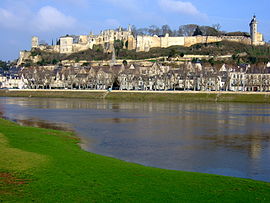Chinon
| Chinon | ||
|---|---|---|

The Château de Chinon, and the Vienne river
|
||
|
||
| Coordinates: 47°10′04″N 0°14′37″E / 47.1678°N 0.2436°ECoordinates: 47°10′04″N 0°14′37″E / 47.1678°N 0.2436°E | ||
| Country | France | |
| Region | Centre-Val de Loire | |
| Department | Indre-et-Loire | |
| Arrondissement | Chinon | |
| Canton | Chinon | |
| Government | ||
| • Mayor (2006–2008) | Jean-Pierre Duvergne | |
| Area1 | 39.02 km2 (15.07 sq mi) | |
| Population (2009)2 | 7,986 | |
| • Density | 200/km2 (530/sq mi) | |
| Time zone | CET (UTC+1) | |
| • Summer (DST) | CEST (UTC+2) | |
| INSEE/Postal code | 37072 / 37500 | |
| Elevation | 27–112 m (89–367 ft) (avg. 37 m or 121 ft) |
|
|
1 French Land Register data, which excludes lakes, ponds, glaciers > 1 km² (0.386 sq mi or 247 acres) and river estuaries. 2Population without double counting: residents of multiple communes (e.g., students and military personnel) only counted once. |
||
1 French Land Register data, which excludes lakes, ponds, glaciers > 1 km² (0.386 sq mi or 247 acres) and river estuaries.
Chinon (French pronunciation: [ʃinɔ̃]) is a commune located in the Indre-et-Loire department in the Region Centre, France. The regional area is called the Touraine, which is known as the "garden of France".
It is well known for its wine, castle, and historic town. Chinon played an important and strategic role during the Middle Ages, having served both French and English kings.
Chinon is in the Loire valley, registered as a UNESCO World Heritage Site since 2000.
The historic town of Chinon is on the banks of the Vienne river about 10 kilometres (6 mi) from where it joins the Loire. Settlement in Chinon dates from prehistoric times, with a pronounced importance for both French and English history in the Middle Ages. At this period rivers were the main trade routes, and the Vienne River joins both the fertile regions of the Poitou and the city of Limoges, and is a tributary of the Loire, which acted as a traffic thoroughfare. The site was fortified early on, and by the 5th century a Gallo-Roman castrum had been established there.
Towards the mid 5th century, a disciple of St Martin, St Mexme, established first a hermitage, and then a monastery to the east of the town. This religious foundation bearing his name flourished in the medieval period, being rebuilt and extended four times. The eventual complex contained a large and highly decorated church and a square of canons' residences. Closure and partial demolition during and after the Revolution of 1789 have damaged this once very important church. The imposing second façade still stands, with its nave dating from the year 1000 A.D. Its important remains have been restored as historical monument and a cultural centre.
...
Wikipedia



